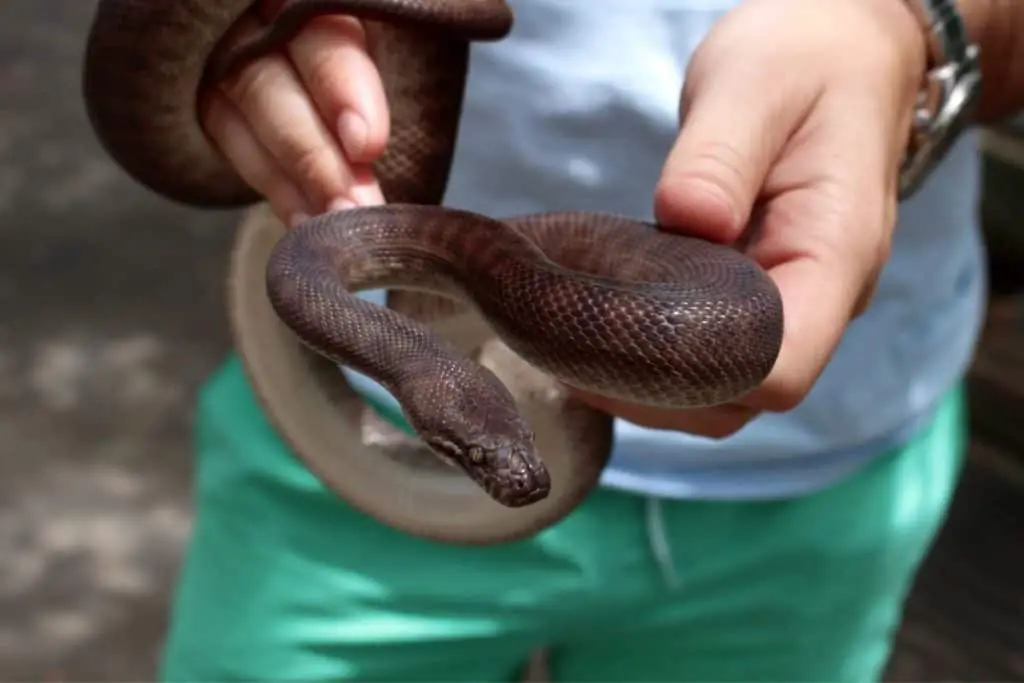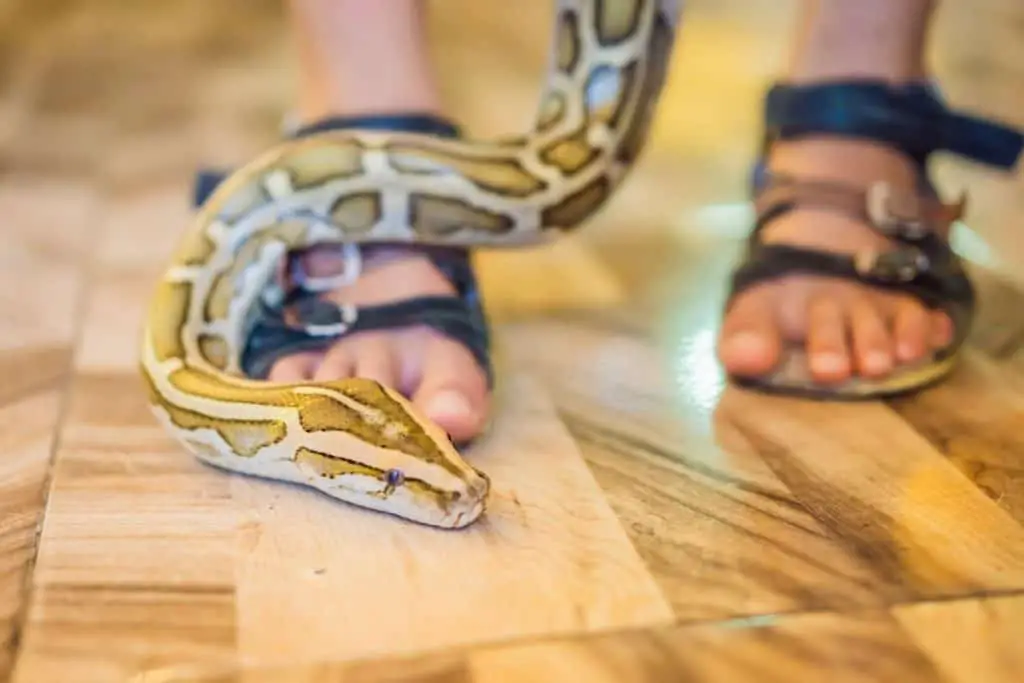If there is one thing that’s sure, it’s that Snakes are quite unique pets in many ways, one of these ways is that they don’t show intelligence in the same ways any other animal does.
But we know that they are smart, so does this mean that they can also learn like other pets? This is a very good question, ane that I pondered myself, so I asked some experts and here is what I found.
So, do snakes learn? Snakes learn, but what they learn is quite limited. Snakes can learn some advanced behaviors like safe and unsafe territories and their boundaries, how to track and hunt down prey faster, and even to do some actions like pressing a button, but they can’t learn to do advanced tricks the way a dog or another animal can.
There is some research on how snakes learn and what they can learn, but it is quite limited. I’ve done my best to research the topic, and in this article, I’m also going to do my best to explain to you – as simply as I could – what you can expect your snake to learn and how you can teach them.
Contents
Do Snakes learn?

Snakes can learn, but they don’t learn in the same way that other animals do, and it’s quite tricky to teach a snake something because the methodologies you will use are quite different from what you would use with a dog, for example.
Let’s take a look at how snakes learn.
How do Snakes learn?
Snakes are actually smart enough to learn new things and remember them, and snakes are definitely smarter than we previously thought them to be. You can learn exactly how smart snakes are in this post.
Snakes learn the same way all other living things learn; trial, error, and motivation. This is good to know, and it also shows why they are so hard to train intentionally to do something.
This leads us to the next question;
Why are snakes so hard to train?

Snakes are especially difficult to train for two main reasons; they bite and they are not easily motivated.
They are not easily motivated
Snakes are not as easy to train as other animals because we teach all other animals using the same ways; we motivate them with food or praise, which work better for some animals than others, but it is very difficult to make it work on snakes.
Dogs will eat at any time of the day, if a dog sees something that looks like it could fit in their mouth, they are going to try to eat it. This makes it very easy to train dogs, but this is not how it works with snakes.
Snakes are extremely energy-efficient. They will not move unless they absolutely have to, and they only need to eat once every couple of weeks or so. How can you train an animal with food if they can go weeks without eating?
Snakes also don’t eat for pleasure. They hunt only to eat, and eat only to survive, so training them with food is difficult.
They bite first, think later
All Snakes will strike the instant they feel they’re threatened. They will not take even a few seconds to think about it or warn the other animal. They will not bark like dogs or meow like cats, they will simply strike and bite first, then deal with the consequences later.
This makes it very difficult to train them, because the moment you do something unfamiliar to them, they are very likely to strike and bite.
How Snakes are motivated?
We’ve now discussed how motivating snakes with praise or food doesn’t work as it does with other animals, how can we train snakes?
Scientists have found out that you can train a snake with food, water, and provide them with safety and a suitable, comfortable environment.
Later in the article, we are going to discuss specific things you can train your snake on so you will understand better how to motivate your snake to learn new things.
What Can Snakes Learn?
I’ve mentioned earlier that snakes can’t learn tricks, but if they can’t learn tricks, what can they actually learn? Let’s see:
How to better navigate their surroundings

Researchers studies snakes by testing them like they test rats in mazes. In a recent study, researchers put water snakes to the test.
In the study, the snakes were placed in a maze with cold water, and this maze was connected to a room with warmer water, which is as strong of a motivator you can give to the snakes as they can get.
With repeated trials, the snakes were able to find their way to the warmer waters faster with every repetition.
What to eat and what not to eat

Scientists have also been to able to confirm that snakes can learn from unpleasant experiences and use what they have learned to avoid such unpleasant experiences in the future.
In a study on garter snakes, the snakes were able to learn from negative feedings. In the study, the snakes were fed earthworms that were injected with a harmless chemical solution. Basically, the snakes were intentionally poisoned to simulate sickness from the earthworms, which is a staple of the garter snakes’ diet in the wild.
A control group of the snakes, of course, were fed earthworms that were not injected with anything, and so they were completely fine. Scientists were then able to notice a change in the behavior of the snakes that got sick, which preferred fish over earthworms in the following trials, showing that they have associated earthworms with sickness.
This is what scientists call a sense of causality, meaning that snakes could make the link between a certain action and the result, and this is a sign of intelligence that were previously thought to not be in snakes.
Speaking of feeding your snake, make sure to learn why you should never feed your snake wild mice here.
The Basics of Training Pet Snakes
Let’s talk about how to teach your snake information and behaviors now that you know what snakes are capable of.
How to teach them it’s time for their meals
You can trach a snake to recognize its feeding time and associate it with something like its cage’s door being open.
Here is how you can train your pet snake to recognize feeding time:
- Have a separate container for feeding your snake
- Prepare a snake hook to handle the snake when it’s hungry. Hungry snakes bite, and the hook is there to keep you both safe.
- When it’s meal time, hook your snake and move it from its cage to the feeding container.
- Once the snake is completely done feeding, move it back (using the hook, of course).
With repetition, the snake will link the new container with food and will start to expect its meal in the feeding time. This also will teach your snake that you, yourself, and your hands, are not food.
How to teach them to not bite
Snakes live a tough life, and they are always on aware of the predators around them like felines and birds, so it’s no wonder that snakes have developed aggressive defensive mechanisms such as instantly biting whatever they deem threatening.
The key to teaching your snake to not bite you is to build trust. Your snake needs time to learn that you are safe and will not harm them.
Give it time to adjust
Snakes need a lot longer to adjust to captivity than other pets. Unlike dogs and cats, snakes are not used to having a home, and this new adjustment is quite significant for them and will take time.
Your snake is also a suspicious creature by nature, so it doesn’t know what around it is safe and what is not, so give it time to learn.
Expose them to humans
Create a habitat for the snake in an area that humans frequent frequently. This could be any room in your house where the foot traffic is high.
The presence of people will assist the snake get acclimated to your voice and smell.
Give it a place to hide
Make sure your snake has several hiding places in its cage. If it feels threatened by you, it will be much more comfortable escaping than confronting you.
Spend time with your snake
Spending time with your snake helps it get used to you quickly. But you should remember to take things slowly. You can just hang around it with it still in the cage first.
Then, you can hang around with the snake’s cage door open. If the snake is comfortable, it should come to you.
Once you start handling the snake, you should let it move freely. It will crawl around you first and explore you. Let it does that.
With time, you can also start getting your snake comfortable with other people in the same way. The thing to remember is to always take things slowly and try to understand the snake’s body language.
It takes patience to train a snake, but the effort is definitely worth it.
Helpful Resources
Snakes show a surprising ability to learn
Scientists confirm snakes can hunt in packs
Operant conditioning in Indigo snake
Conditioned discrimination of airborne odorants by garter snakes (Thamnophis radix and T. sirtalis sirtalis).
If you like this article, please share it!


